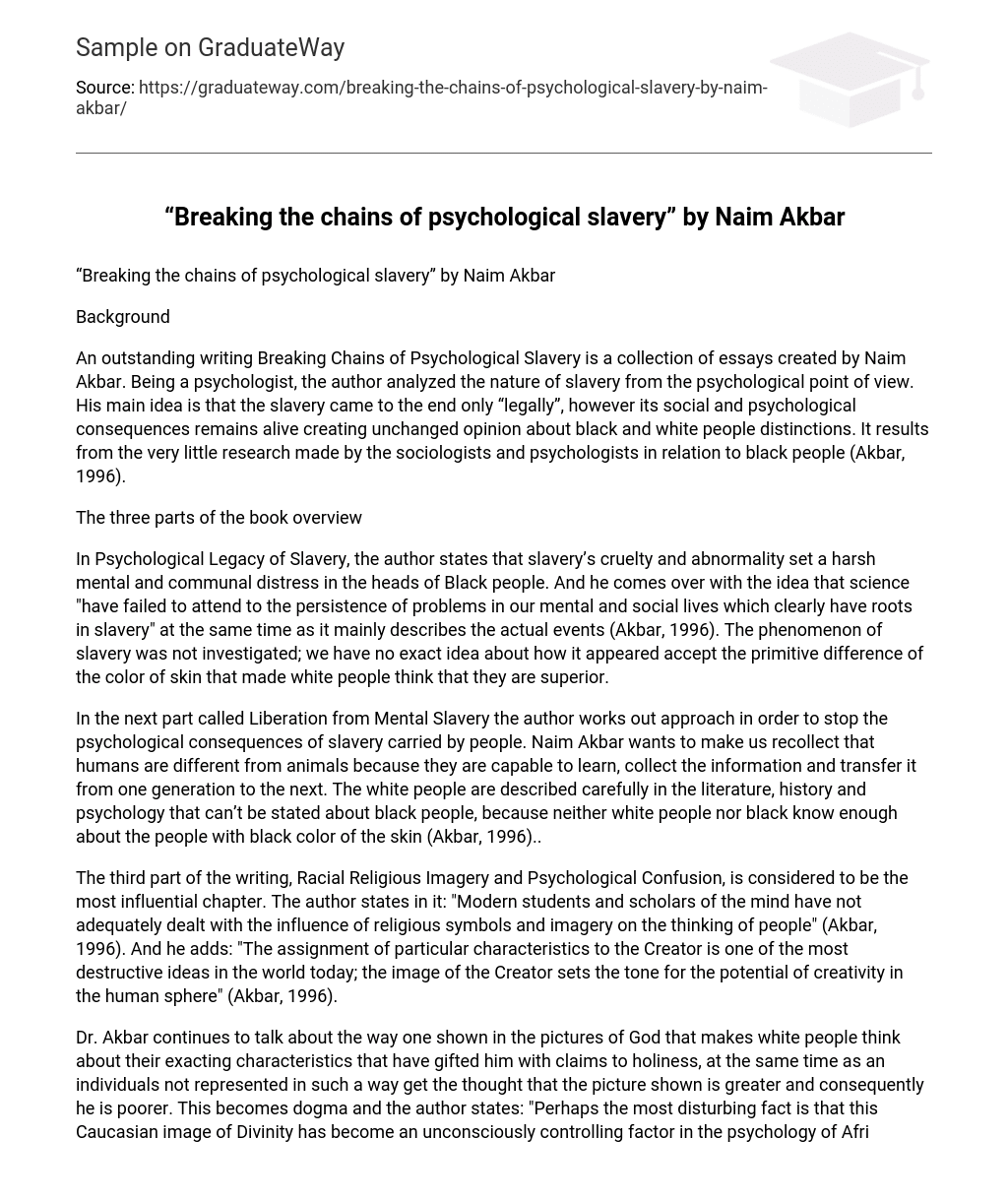Background
An outstanding writing Breaking Chains of Psychological Slavery is a collection of essays created by Naim Akbar. Being a psychologist, the author analyzed the nature of slavery from the psychological point of view. His main idea is that the slavery came to the end only “legally”, however its social and psychological consequences remains alive creating unchanged opinion about black and white people distinctions. It results from the very little research made by the sociologists and psychologists in relation to black people (Akbar, 1996).
The three parts of the book overview
In Psychological Legacy of Slavery, the author states that slavery’s cruelty and abnormality set a harsh mental and communal distress in the heads of Black people. And he comes over with the idea that science “have failed to attend to the persistence of problems in our mental and social lives which clearly have roots in slavery” at the same time as it mainly describes the actual events (Akbar, 1996). The phenomenon of slavery was not investigated; we have no exact idea about how it appeared accept the primitive difference of the color of skin that made white people think that they are superior.
In the next part called Liberation from Mental Slavery the author works out approach in order to stop the psychological consequences of slavery carried by people. Naim Akbar wants to make us recollect that humans are different from animals because they are capable to learn, collect the information and transfer it from one generation to the next. The white people are described carefully in the literature, history and psychology that can’t be stated about black people, because neither white people nor black know enough about the people with black color of the skin (Akbar, 1996)..
The third part of the writing, Racial Religious Imagery and Psychological Confusion, is considered to be the most influential chapter. The author states in it: “Modern students and scholars of the mind have not adequately dealt with the influence of religious symbols and imagery on the thinking of people” (Akbar, 1996). And he adds: “The assignment of particular characteristics to the Creator is one of the most destructive ideas in the world today; the image of the Creator sets the tone for the potential of creativity in the human sphere” (Akbar, 1996).
Dr. Akbar continues to talk about the way one shown in the pictures of God that makes white people think about their exacting characteristics that have gifted him with claims to holiness, at the same time as an individuals not represented in such a way get the thought that the picture shown is greater and consequently he is poorer. This becomes dogma and the author states: “Perhaps the most disturbing fact is that this Caucasian image of Divinity has become an unconsciously controlling factor in the psychology of African-Americans.” Really, there are no black people on the religious images that made white people think that they are better than blacks and can be “masters” and they must be “slaves” (Akbar, 1996). At least this is the opinion of African Americans that still controls their psychology not allowing them feel equal to white people. Actually this fact was revealed but nothing was done by now to control it.
My own conclusions
Having read all three parts, I generally agreed with the author’s views on slavery. I want to admit that some of his ideas differ from my own ones, however as a whole the writing is very actual and important creation. In chapter one the author stated that the slave was hardly allowed to have any possessions. This led to jealousy arising in relation to the slave-owner that in its turn provoked damages and detestation towards him. It is easy to agree with the author here because from the psychological point of view the person who is hardly given only the things of the first necessity becomes jealous and aggressive looking at someone’s wealth. He can’t understand one that person is given what he is not allowed to have (Akbar, 1996).
Speaking about the second part, I can’t but accept the unique idea of Naim Akbar. We really possess very little information about black people, we just know that they were slaves and this definition travels from one generation to another without any visible changes. Slavery ended, it does not exist in our world now. We do not here about it in news reports, we can’t meet it in everyday live. However it lives in our minds, in the minds of black and white people. Nothing was done; we can’t trace any historical progress in relation to psychological abolition of slavery. This is the result of the lack of the research in the field of social and psychological peculiarities of black people and psychological origin of slavery as a phenomenon that is discussed by the author in the third part of the book. This research was started by Naim Akbar and should be continued by other scientists.
Bibliography
Akbar, Naim, (1996). Breaking the Chain of Psychological Slavery. Tallahassee, Florida: Mind Productions & Associates, Inc.





